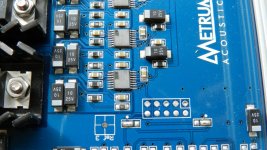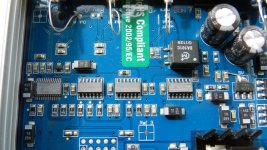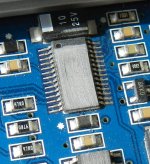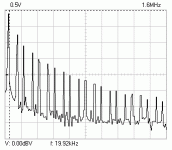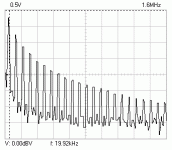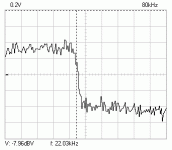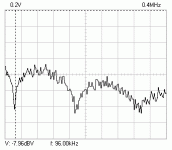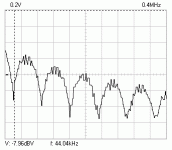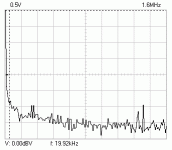I can't deal with NOS without serious filters. Because once you get used to an bad/unatural sound, even the real instruments will sound "bad".
LOL
Two things worth saying:
First, The NOS/OS difference is rather small comparing to sigma-delta vs R2R.
Likewise the impact of the use of one digital filter rather than the other is MINUSCULE.
The Metrum sounds good (according to every opinion i heard, since I havent heard it yet) because employs ladder dacs, which in its implementation reaches 18 bit (assuming the measurement of audiocritic was correct) and it accepts highres signals. All this with at a small cost. 8x PCM1794UK costs half of the price the octave sells for and would be impossible to make it as cheap, even with half the dacs.
Now, the second thing, to the owners and diyers, in your opinion is possible to feed i2s to the dacs of the Quad/Octave? spdif sucks, and it's the biggest bottleneck IMO.
First, The NOS/OS difference is rather small comparing to sigma-delta vs R2R.
Likewise the impact of the use of one digital filter rather than the other is MINUSCULE.
The Metrum sounds good (according to every opinion i heard, since I havent heard it yet) because employs ladder dacs, which in its implementation reaches 18 bit (assuming the measurement of audiocritic was correct) and it accepts highres signals. All this with at a small cost. 8x PCM1794UK costs half of the price the octave sells for and would be impossible to make it as cheap, even with half the dacs.
Now, the second thing, to the owners and diyers, in your opinion is possible to feed i2s to the dacs of the Quad/Octave? spdif sucks, and it's the biggest bottleneck IMO.
The Octave I ordered has arrived at the shop and today I'm going to pick it up.
Before I start listening to it seriously, I'd like some burn in first, so there will be no comments on the sound quality for a few weeks. In the meantime I will be taking some measurements that some have asked for, though.
I downloaded the demo version of Arta. Apart from the PC-DSO I mentioned in a previous post, I remembered that I do have an ADC; it's built into my Pioneer PDR-555RW. The mech doesn't work anymore, but if I fix the corroded through vias on the main pcb caused by a leaky supercap (common fault), I might get the monitoring function working and can I record the digitized signal from the SPDIF input on my PC. The ADC in the '555RW is an AK5340-VS. But for now it'll be the PC-DSO.
Please let me know what you would like me to measure.
Before I start listening to it seriously, I'd like some burn in first, so there will be no comments on the sound quality for a few weeks. In the meantime I will be taking some measurements that some have asked for, though.
I downloaded the demo version of Arta. Apart from the PC-DSO I mentioned in a previous post, I remembered that I do have an ADC; it's built into my Pioneer PDR-555RW. The mech doesn't work anymore, but if I fix the corroded through vias on the main pcb caused by a leaky supercap (common fault), I might get the monitoring function working and can I record the digitized signal from the SPDIF input on my PC. The ADC in the '555RW is an AK5340-VS. But for now it'll be the PC-DSO.
Please let me know what you would like me to measure.
Last edited:
Well measurements of the octave have been done here:
http://www.nosminidac.nl/downloads/octavehificritic.pdf
You can either do the same or dunno really what else. Jitter maybe but I dont think your equip can measure it.
http://www.nosminidac.nl/downloads/octavehificritic.pdf
You can either do the same or dunno really what else. Jitter maybe but I dont think your equip can measure it.
Yes, we know measurements have already been made. It's by the request of some that I do my own. If need be, I'd have access to one of the Audio Precisions we have at work, but I'd like to see what some simpler stuff like a PC-DSO will show. Jitter measurements will indeed be out of the question.
Last edited:
Hi Richard,
I was reading the Martin Colloms review and noticed he reported an 18-bit measured resolution from the Metrum Octave. The DAC8581 is 16-bits, so I'm not sure how to reconcile Martin's lab report. Simply paralleling DAC chips will, as you know, lower the noise floor, but I don't believe it increases net bit resolution. Perhaps, I've overlooked something.
 What is your assessment of this?
What is your assessment of this?No, I don't think you've overlooked something - at least not in this respect  I found a few inconsistencies with Martin Colloms' technical report (which I'll expound on if there's interest). As he doesn't talk about how he determined the alleged 18bits, I remain unconvinced of his conclusion. I think he might have been estimating the overall linearity of the DACs themselves - so my take is that he guesstimated their DNL (combined) was around the 18 bit level, meaning 0.25LSB DNL. I'm open to other offers for the 18bit claim. Its not really very easy to estimate the number of bits a DAC has purely from the measurements he's shown there.
I found a few inconsistencies with Martin Colloms' technical report (which I'll expound on if there's interest). As he doesn't talk about how he determined the alleged 18bits, I remain unconvinced of his conclusion. I think he might have been estimating the overall linearity of the DACs themselves - so my take is that he guesstimated their DNL (combined) was around the 18 bit level, meaning 0.25LSB DNL. I'm open to other offers for the 18bit claim. Its not really very easy to estimate the number of bits a DAC has purely from the measurements he's shown there.
Oh I just had a thought as I am writing this - perhaps the poor FFT plot represents quantizing distortion due to incorrect dither applied to his test waveform. Given that he's estimated 18bits, his test signal could have been dithered at the 18bit level resulting in that plot. Plausible?
Oh I just had a thought as I am writing this - perhaps the poor FFT plot represents quantizing distortion due to incorrect dither applied to his test waveform. Given that he's estimated 18bits, his test signal could have been dithered at the 18bit level resulting in that plot. Plausible?
The Octave is now playing in my system.
This thread has gone waaaaaay off topic, so with this picture I'd like to go back to the original question. The answer can still not be given with absolute certainty. Is it the DAC8581? Seems to be, but who knows?
For those that still want a closer look, here's about as high res a picture as I can upload here.
BTW, this one looks professionally soldered in a reflow process for SMT components, and the bottom side of the pcb clearly shows the use of wave-soldering for the through-hole components. This confirms my assumption that Metrum's products are made by an OEM for Acelec, and not by Acelec themselves (himself?).
This thread has gone waaaaaay off topic, so with this picture I'd like to go back to the original question. The answer can still not be given with absolute certainty. Is it the DAC8581? Seems to be, but who knows?
For those that still want a closer look, here's about as high res a picture as I can upload here.
BTW, this one looks professionally soldered in a reflow process for SMT components, and the bottom side of the pcb clearly shows the use of wave-soldering for the through-hole components. This confirms my assumption that Metrum's products are made by an OEM for Acelec, and not by Acelec themselves (himself?).
Attachments
Last edited:
Thanks for posting this up - its now clear my original guess was actually off by one count. The DAC is actually a DAC8580 - the tell-tale is that on the DAC8581 pins 15 and 16 are DGND and DVDD respectively. In this pic its clear that they're connected together so it can't be the DAC8581 after all  On DAC8580 pin15 is for resetting the internal digital filter, and that's not being used.
On DAC8580 pin15 is for resetting the internal digital filter, and that's not being used.
If it really is the DAC8580, the picture would indeed confirm that this DAC, which has a programmable oversampling digital filter has indeed been set to filterless NOS.
The connection of the lower four pins on the bottom right to the same plane (5 AGND, 6 BPB', 7 OSR1 and 8 OSR2) and the upper two on the right (15 RSTB' and 16 DGND) to another plane means that, according to the datasheet, the DAC is set for "standard DAC operation" (i.e. no oversampling, filter off):
Standard DAC operation:
BPB': 0
RSTB': 0
OSR2: don't care
OSR1: don't care
The connection of the lower four pins on the bottom right to the same plane (5 AGND, 6 BPB', 7 OSR1 and 8 OSR2) and the upper two on the right (15 RSTB' and 16 DGND) to another plane means that, according to the datasheet, the DAC is set for "standard DAC operation" (i.e. no oversampling, filter off):
Standard DAC operation:
BPB': 0
RSTB': 0
OSR2: don't care
OSR1: don't care
Last edited:
Correction to my previous post: "bottom right" must of course be "bottom left".
The printing has also been sanded off the glue logic. I'm thinking this thing isn't as proprietary as has been assumed. If the DACs really are the DAC8580, their interface is already "compatible with right justified digital audio format" according to the datasheet. Wouldn't that just mean a SPDIF receiver that feeds the eight DAC's through some standard logic ICs?
The printing has also been sanded off the glue logic. I'm thinking this thing isn't as proprietary as has been assumed. If the DACs really are the DAC8580, their interface is already "compatible with right justified digital audio format" according to the datasheet. Wouldn't that just mean a SPDIF receiver that feeds the eight DAC's through some standard logic ICs?
Attachments
Last edited:
The reported THD+N in that article is -60dB (page 10). That is NOT the 18 bit resolution claimed previously in the article, it is shy of 10 bit real resolution.Well measurements of the octave have been done here:
http://www.nosminidac.nl/downloads/octavehificritic.pdf
Another measurement is needed.
No, I don't think you've overlooked something - at least not in this respectI found a few inconsistencies with Martin Colloms' technical report (which I'll expound on if there's interest). As he doesn't talk about how he determined the alleged 18bits, I remain unconvinced of his conclusion. I think he might have been estimating the overall linearity of the DACs themselves - so my take is that he guesstimated their DNL (combined) was around the 18 bit level, meaning 0.25LSB DNL. I'm open to other offers for the 18bit claim. Its not really very easy to estimate the number of bits a DAC has purely from the measurements he's shown there.
Oh I just had a thought as I am writing this - perhaps the poor FFT plot represents quantizing distortion due to incorrect dither applied to his test waveform. Given that he's estimated 18bits, his test signal could have been dithered at the 18bit level resulting in that plot. Plausible?
I concur, that seems plausible to me as well. I think he did say, "about" 18-bits, which could also be about, 17-bits, or maybe, even about 16-bits, I suppose.
It makes sense that Metrum would utilize the DAC8580 over the DAC8581. The 8580 features a normal 3-wire audio input port, while the 8581 features a port which does not facilitate digital audio signals.
Last edited:
Hi,
I think you should.
I also noticed a few things, but being in the industry and all I think I should avoid comments in public...
Ciao T
I found a few inconsistencies with Martin Colloms' technical report (which I'll expound on if there's interest).
I think you should.
I also noticed a few things, but being in the industry and all I think I should avoid comments in public...
Ciao T
OK, my PC-DSO isn't any good at measuring very low level signals or precise frequency responses, for that I refer you to the Hifi Critic review.
Much more interesting, though, are how sinewaves look through a NOS DAC. No doubt it's what has kept so many from taking NOS seriously and still do for those that haven't heard it. And it´s those measurements you don´t find in reviews.
I used a Micromega DAC1 to get the result from a "conventional" DAC. This DAC isn't capable of 96 kHz sampling frequency, so only the results for 44k1 are given. I measured the Octave at 44k1 and 96 kHz to show the difference.
The pictures are from left to right:
Octave, 44.1 kHz, 1 kHz sine;
Octave, 96 kHz, 1 kHz sine;
DAC1, 44.1 kHz, 1 kHz sine;
Octave, 44.1 kHz, 5 kHz sine;
Octave, 96 kHz, 5 kHz sine;
DAC1, 44.1 kHz, 5 kHz sine;
Octave, 44.1 kHz, 20 kHz sine;
Octave, 96 kHz, 20 kHz sine;
DAC1, 44.1 kHz, 20 kHz sine.
Much more interesting, though, are how sinewaves look through a NOS DAC. No doubt it's what has kept so many from taking NOS seriously and still do for those that haven't heard it. And it´s those measurements you don´t find in reviews.
I used a Micromega DAC1 to get the result from a "conventional" DAC. This DAC isn't capable of 96 kHz sampling frequency, so only the results for 44k1 are given. I measured the Octave at 44k1 and 96 kHz to show the difference.
The pictures are from left to right:
Octave, 44.1 kHz, 1 kHz sine;
Octave, 96 kHz, 1 kHz sine;
DAC1, 44.1 kHz, 1 kHz sine;
Octave, 44.1 kHz, 5 kHz sine;
Octave, 96 kHz, 5 kHz sine;
DAC1, 44.1 kHz, 5 kHz sine;
Octave, 44.1 kHz, 20 kHz sine;
Octave, 96 kHz, 20 kHz sine;
DAC1, 44.1 kHz, 20 kHz sine.
Attachments
-
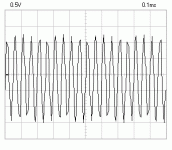 oct_20k_dso_96k.gif8 KB · Views: 76
oct_20k_dso_96k.gif8 KB · Views: 76 -
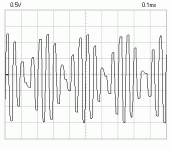 oct_20k_dso_44k.gif7.6 KB · Views: 85
oct_20k_dso_44k.gif7.6 KB · Views: 85 -
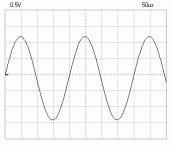 dac1_5k_dso_44k.gif5.3 KB · Views: 75
dac1_5k_dso_44k.gif5.3 KB · Views: 75 -
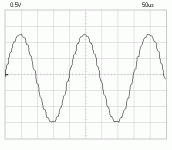 oct_5k_dso_96k.gif5.4 KB · Views: 83
oct_5k_dso_96k.gif5.4 KB · Views: 83 -
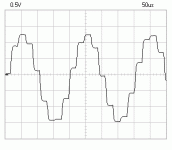 oct_5k_dso_44k.gif5.4 KB · Views: 83
oct_5k_dso_44k.gif5.4 KB · Views: 83 -
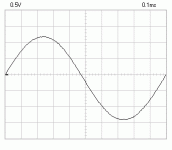 dac1_1k_dso_44k.gif4.7 KB · Views: 296
dac1_1k_dso_44k.gif4.7 KB · Views: 296 -
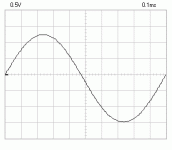 oct_1k_dso_96k.gif4.8 KB · Views: 335
oct_1k_dso_96k.gif4.8 KB · Views: 335 -
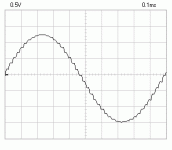 oct_1k_dso_44k.gif4.8 KB · Views: 355
oct_1k_dso_44k.gif4.8 KB · Views: 355 -
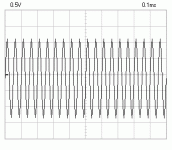 dac1_20k_dso_44k.gif7.3 KB · Views: 73
dac1_20k_dso_44k.gif7.3 KB · Views: 73
Last edited:
I also did some spectrum analysis with the same variations as my previous post, again from left to right:
Octave, 44.1 kHz, white noise;
Octave, 96 kHz, white noise;
DAC1, 44.1 kHz, white noise;
Octave, 44.1 kHz, spectrum of 20 kHz sine;
Octave, 96 kHz, spectrum of 20 kHz sine;
DAC1, 44.1 kHz, spectrum of 20 kHz sine;
Clearly visible are the images in the NOS DAC.
If you ask me if I can hear any of the really distorted looking signals coming out of the Octave the answer is a very firm NO, I don't. Given that these distortions are caused by frequency components outside the audible band, I'm not at all surprised that I really don't hear them, simply because I can't. As I wrote before: the perfect low pass filter is already in us!
Octave, 44.1 kHz, white noise;
Octave, 96 kHz, white noise;
DAC1, 44.1 kHz, white noise;
Octave, 44.1 kHz, spectrum of 20 kHz sine;
Octave, 96 kHz, spectrum of 20 kHz sine;
DAC1, 44.1 kHz, spectrum of 20 kHz sine;
Clearly visible are the images in the NOS DAC.
If you ask me if I can hear any of the really distorted looking signals coming out of the Octave the answer is a very firm NO, I don't. Given that these distortions are caused by frequency components outside the audible band, I'm not at all surprised that I really don't hear them, simply because I can't. As I wrote before: the perfect low pass filter is already in us!
Attachments
Last edited:
Do you think it does even hold a candle to DAC1?
To me, the 5kHz @ 44.1kHz one looks like is a 4 bit sinusoide... Those distortions are not outside the audio band, I bet that using some headphones you could hear the difference.
I am very interested in a mix of 19+20kHz 1:1 - for both of them.
To me, the 5kHz @ 44.1kHz one looks like is a 4 bit sinusoide... Those distortions are not outside the audio band, I bet that using some headphones you could hear the difference.
I am very interested in a mix of 19+20kHz 1:1 - for both of them.
Last edited:
Whether or not this is relevant I don't know. But I'm interested in seeing what the spectrum looks like at low frequencies when replaying the 20kHz sine. We've got what the spectrum looks like above it, but not below, does stuff fold back into the audio band.
Of course if you show the 19+20kHz tone we will get to see what it looks like down low anyway as the product of the IMD test.
Of course if you show the 19+20kHz tone we will get to see what it looks like down low anyway as the product of the IMD test.
- Status
- This old topic is closed. If you want to reopen this topic, contact a moderator using the "Report Post" button.
- Home
- Source & Line
- Digital Line Level
- Metrum Octave Dac - What are the Chips used
